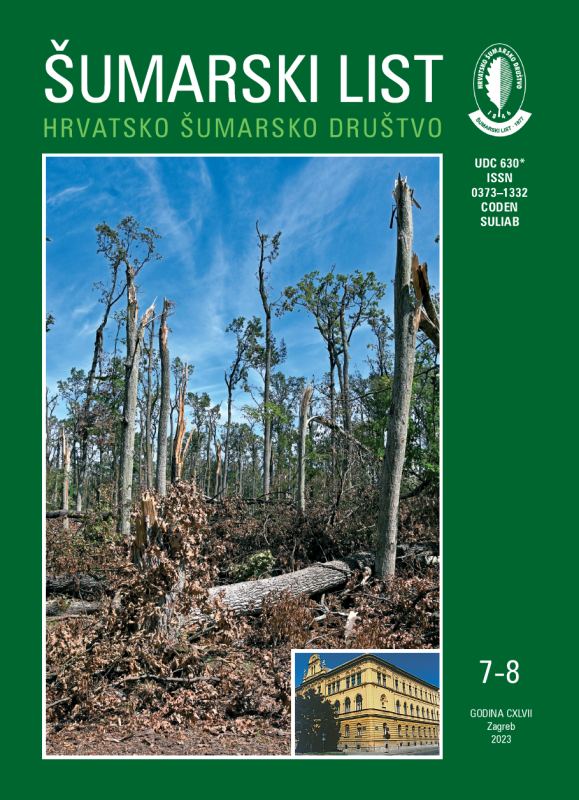
broj: 7-8/2023
pdf (8,38 MB) |
|
||||||||||||||
| RIJEČ UREDNIŠTVA | ||
| Uredništvo | ||
| The effects of stormy weather on forests pdf HR EN | 305 | |
| IZVORNI ZNANSTVENI ČLANCI | ||
| Darko Bakšić, Nera Bakšić, Daniel Krstnošić, Nikola Pernar, Ivan Perković, Stjepan Mikac, Vibor Roje, Branimir Krtalić | UDK 630* 114.3 (001) https://doi.org/10.31298/sl.147.7-8.1 | |
| Forest floor and soil properties of silver fir and european hop hornbeam forests (Ostryo-abietetum /Fukarek 1963/Trinajstić 1983) on Biokovo mountain pdf HR EN | 307 | |
| Tomislav Poršinsky, Zoran Bumber, Zdravko Pandur, Andreja Đuka | UDK 630* 312 (001) https://doi.org/10.31298/sl.147.7-8.2 | |
| Forwarder’s working range – from modeling to support for operational application pdf HR EN | 319 | |
| Željko Španjol, Ivana Gašparović, Marko Vučetić, Dunja Zbiljski, Milan Vojinović, Vedran Sušilović, Ivan Ljubić, Katarina Korov, Boris Dorbić | UDK 630* 934 + 187 (001) https://doi.org/10.31298/sl.147.7-8.3 | |
| The biological and ecological characteristics of an special forest vegetation reserve Kočje - Korčula island pdf HR EN | 335 | |
| Dragana Skorup, Miroslav Vujasinović, Goran Marinković, Ilija Grgić, Boban Miletić | UDK 630* 615 (001) https://doi.org/10.31298/sl.147.7-8.4 | |
| Assessment of forest resources based on Sentinel-2 images – case study Derventa, BiH (Cadastral municipality of Brezici) pdf HR EN | 353 | |
| Branislav Trudić, Biljana Kiprovski, Saša Kostić, Srđan Stojnić, Marko Kebert, Aleksandar Ivezić, Andrej Pilipović | UDK 630* 165 (001) https://doi.org/10.31298/sl.147.7-8.5 | |
| Are oxidative stress screening tests enough for small scale Quercus robur genetic monitoring? pdf HR EN | 363 | |
| PREGLEDNI ČLANCI | ||
| Anamarija Jazbec | UDK 630* 965.3 https://doi.org/10.31298/sl.147.7-8.6 | |
| How the results of state secondary high school final exams influence the average grade and duration of undergraduate study at Faculty of forestry and wood technology, University of Zagreb? pdf HR EN | 375 | |
| Mirjana Ćuk, Radenko Ponjarac, Dušan Igić, Miloš Ilić, Marius Oldja, Dragana Vukov, Andraž Čarni | UDK 630* 233+187 https://doi.org/10.31298/sl.147.7-8.7 | |
| Historical overview of the Deliblato sands afforestation pdf HR EN | 383 | |
| Summary Deliblato Sands is one of the largest sandy areas in Europe. Given that developing of vegetation on the sand is a slow process, followed by human activities that devastate the plant cover (grazing, deforestation), the free-moving sand on Deliblato Sands exited until the 18th century. Unbound sand hindered the development of agriculture in the entire southern Banat region, so it was necessary to start a more intensive process of restraining sand masses. The afforestation of this area began in 1818 and is still ongoing. In the process of afforestation, nine periods can be recognized that differ in relation to afforestation/reforestation techniques, the choice of species or the organizational structure of the forestry units (and countries) of the area of Deliblato Sands belonged throughout history. The most significant results in the binding of free moving sand were achieved by the application of black locust (Robinia pseudoacacia L.) seedlings with juniper scrub (Juniperus communis L.) laid down on open sandy areas and sowing different species of grass between the rows of seedlings. This technique has been applied since the IV afforestation period (1878-1898). The largest areas were afforested in the V period (1898-1918), when parts of Deliblato Sands were formally protected for the first time in history as areas of importance for the preservation of biodiversity. The species most used in afforestation are black locust (Robinia pseudoacacia L.), Scots pine and black pine (Pinus sylvestris L., Pinus nigra J. F. Arnold), poplars (Populus sp.), and some shrubby (e.g. Juniperus virginiana L.) and herbaceous species (e. g. Ammophilla arenaria (L.) Link, Festuca vaginata Willd., Leymus arenarius (L.) Hochst., Carex arenaria L.). Today, Robinia pseudoacacia L. is most common tree species on Deliblato Sands and it occupies almost a third of the entire area. Key words: stabilization of sand; vegetation on sand; continental sand dunes; black locust | ||


